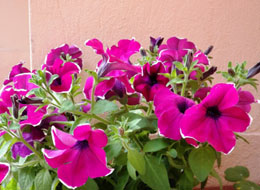Petunia is a flowering plant that can be grown in pots or flower beds. Ample sunlight, well-drained soil, and proper watering will ensure multiple blooms. This write-up provides tips for growing and caring for this plant.

Petunia is a flowering plant that is native to South America. It belongs to
Solanaceae family. It produces beautiful, fragrant, trumpet-shaped flowers that have delicate petals. The flowers come in a wide range of colors. It can be grown in pots, hanging baskets, or flower beds. You can also grow them as borders in your flower garden.
Petunia Flowers
Due to their vibrant and lively colors, they are considered to be one of the popular flowering annuals. They bloom from spring until frost. They are classified into grandiflora, multiflora, milliflora, and groundcover. Multiflora petunias, as the name suggests, produce big-sized blooms. Their size ranges from 3-4 inches. Some of them might have a cascading habit and therefore, look great in hanging pots. Multiflora produce many blossoms, but are smaller in size. The compact flowers are bunched together and look visually pleasing. Milliflora, as the name suggests, are miniature flowers. They can be used as edging plants. Since these are very small, mixing them with other flowering annuals in containers is a great idea. The groundcover petunias can be used to decorate a retaining wall.
Growing Petunias
First of all, you need to decide whether you want to grow these flowers in pots, hanging baskets, or flower beds.
Selection of the Site
The most important aspect is the selection of a site. Make sure that you select a site that receives at least 6 hours of sunlight. Though this plant can tolerate some shade, you will see profuse flowering only if they receive ample sunshine. As far as the soil is concerned, make sure that it is well-drained. You can also replenish the soil by using compost or manure. In case the soil is a bit lighter, adding manure will facilitate the absorption of water and nutrients.
Planting
Petunias may be grown from seeds or seedlings. You can also buy the plants from a gardening center. If you are growing this plant from seeds, the seeds should be sown 8-10 weeks before the time of planting. The seeds should be spread on the top of the container. It would be best to use a moist potting mix. Since the seeds are very tiny and difficult to manage, planting the seedlings would be more convenient. As spring approaches, you need to select a suitable site. If you are growing them in flower beds, keep a distance of 10-18 inches between them. If you are growing them in pots, you can place 2-3 plants in the center.
Watering and Fertilizing
If you have planted this flowering plant in pots or window boxes, make sure that you water it frequently. The new plants need to be watered more often, but make sure you don't go on a watering spree. You must also add suitable fertilizers as that will facilitate profuse flowering. You can fertilize using a liquid fertilizer that is meant for flowering plants.
Pruning
Don't forget to prune this plant. You must remove the spent flowers and weeds. If you don't remove the weeds, they will compete with petunias for nutrients, which might hamper the growth of this flowering plant. Pruning and pinching is also important, as it facilitates profuse flowering and discourages excessive vegetative growth.
Do follow the aforementioned instructions to provide the ideal conditions that are needed by this plant for proper growth, and be ready to see beautiful petunias blooming in your garden.






 Petunia is a flowering plant that is native to South America. It belongs to Solanaceae family. It produces beautiful, fragrant, trumpet-shaped flowers that have delicate petals. The flowers come in a wide range of colors. It can be grown in pots, hanging baskets, or flower beds. You can also grow them as borders in your flower garden.
Petunia is a flowering plant that is native to South America. It belongs to Solanaceae family. It produces beautiful, fragrant, trumpet-shaped flowers that have delicate petals. The flowers come in a wide range of colors. It can be grown in pots, hanging baskets, or flower beds. You can also grow them as borders in your flower garden.